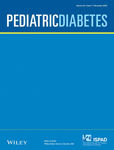A longitudinal assessment of diabetes autoantibodies in the SEARCH for diabetes in youth study
Funding information: Centers for Disease Control and Prevention; National Institute of Diabetes and Digestive and Kidney Diseases; National Institutes of Health; Wake Forest University School of Medicine, Grant/Award Numbers: 200-2010-35171, U01 DP000250, U48/CCU919219; Seattle Children's Hospital, Grant/Award Numbers: U18DP002710-01, U01 DP000244, U58/CCU019235-4; University of North Carolina at Chapel Hill, Grant/Award Numbers: U18DP002708, U01 DP000254, U48/CCU419249, U18DP000247-06A1, U01 DP000247, U48/CCU819241-3; Cincinnati's Children's Hospital Medical Center, Grant/Award Numbers: 1U18DP002709, U01 DP000248, U48/CCU519239; University of Colorado Denver; Kaiser Permanente Southern California, Grant/Award Numbers: U18DP002714, U01 DP000246, U48/CCU919219; The Population Based Registry of Diabetes in Youth Study, Grant/Award Numbers: U18DP006139, U18DP006136, U18DP006134, U18DP006133, 1U18DP006131
Abstract
To assess changes in diabetes autoantibodies (DAs) over time in children and young adults with diabetes and determine whether observed changes were associated with demographic characteristics, clinical parameters and diabetes complications. Participants had DAs measured at baseline (10.3 ± 7.1 months after diabetes diagnosis) and at 12, 24 months and ≥5 years after the baseline measurement. At the ≥5-year follow-up, the presence of diabetes complications was assessed. We examined the associations between change in number of positive DAs and changes in individual DA status with the participants' characteristics and clinical parameters over time. Out of 4179 participants, 62% had longitudinal DA data and 51% had complications and longitudinal DA data. In participants with ≥1 baseline positive DA (n = 1699), 83.4% remained positive after 7.3 ± 2.3 years duration of diabetes. Decrease in number of positive DAs was associated with longer diabetes duration (p = 0.003 for 1 baseline positive DA; p < 0.001 for 2 baseline positive DAs) and younger age at diagnosis (p < 0.001 for 2 baseline positive DAs). No associations were found between change in number of positive DAs in participants with ≥1 baseline positive DA (n = 1391) and HbA1c, insulin dose, acute, or chronic complications after 7.7 ± 1.9 years duration of diabetes. DA status likely remains stable in the first 7 years after diabetes diagnosis. Younger age at diabetes diagnosis and longer duration were associated with less persistence of DAs. Measuring DAs after initial presentation may aid in diabetes classification but not likely in predicting the clinical course.
CONFLICT OF INTEREST
The authors have no conflicts of interest to disclose.
Open Research
DATA AVAILABILITY STATEMENT
The data that support the findings of this study are available from the corresponding author upon reasonable request.




